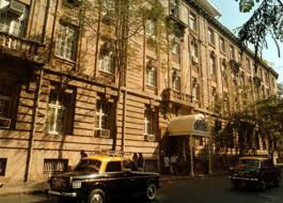Bombay House - Tata Power Company - Registered Office

Bombay House is a historic privately owned building in Mumbai that serves as the head office of the Tata Group. Situated near Flora Fountain, it was completed in 1924 and has been the Tata Group's headquarters since then.
A plot of ground measuring 2,365 sq yd (1,977 m2) was put up by the Bombay Municipality for sale in Bombay and then purchased by the Tata Group. It was observed that the various Tata concerns could not be accommodated in Navsari buildings and Navsari Chambers which they had been occupying since 1904. The Tata Group is perhaps the only Indian corporate to name its headquarters after a city where it started its journey. Bombay House, the global corporate HQ of the $106.34 billion group. At that time, the group ran four businesses-textiles, hotels, steel and power-under the leadership of Sir Dorabji Tata, the elder son of group founder Jamsetji Tata. It was from this Edwardian building that Dorabji Tata diversified the portfolio into insurance, soaps, detergents and cooking oil. And it is in this building where the first Indian airline was conceptualized (1932) and where the largest global acquisition (Corus, for $13 billion in 2007) by an Indian group was made.
Year of establishment
Tata Power’s office was established on the 3rd floor of Bombay House in the year 1924.

Present set up
The office set up consists:
- MD Office
- ED Office
- CFO Office
- Corporate Communication Office
- Strategy Office
- Performance Analysis
- Secretarial Office
- Conference rooms
Registered Office - Bombay House


Historical Data
The Tata Hydro-Electric Power Supply Company Limited (Tata Hydro), The Andhra Valley Power Supply Company Limited (Andhra Valley) and The Tata Power Company Limited (Tata Power) were incorporated in 1910, 1916 and 1919 respectively. They owned and operated three hydro generating stations and one thermal station consisting of six thermal units.
The Companies functioned for all practical purposes as one interconnected grid and supplied power to the highly industrialized area in and around Bombay city in Western Maharashtra.
TEC were pioneers in the power engineering field and introduced the latest state-of-the-art technology in power generation, high voltage transmission and distribution, load dispatching and system management since they commenced operations more than 105 years ago.
TEC operated in a unique manner. They virtually functioned as one Company having a common area of supply, common tariffs, common consumers and common employees. They also had a common Chairman, Managing Director and held joint Board Meetings. Most of the assets were owned jointly and income and expenditure were also shared jointly in a pre-determined ratio of 2:3:5, between Tata Hydro, Andhra Valley and Tata Power respectively.